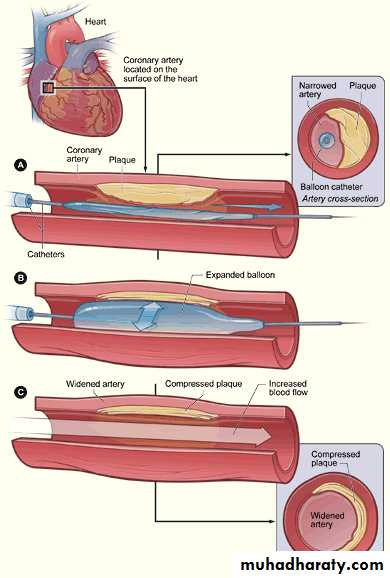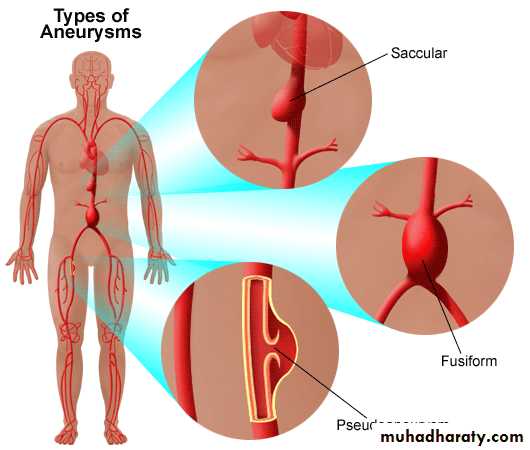Arterial Disorders
Introduction:Arterial disease includes:
Acute arterial occlusion
Chronic arterial occlusion
Aneurysms
Chronic Arterial Occlusion:
Causes: atherosclerosisRisk factors:
• Hyperlipidemia• Hypertension
• Diabetes melitus
• Obesity and decrease physical activity
• Smoking
• Male sex
• Advanced age
Pathogenesis:
Clinical presentation:• Intermittent claudication
• Rest pain
• Coldness and color changes
• Ulceration and gangrene
• Reduced sensation, numbness, parasthesia
• Motor weakness
• Absent or diminished pulses
• Arterial briut
• Beurger’s angle
Investigations:
• Doppler ultrasound• Duplex ultrasound.
• Angiography (gold standard)
• CT angiography and MRA.
Non-surgical treatment:
• Stop smoking• Control of blood sugar
• Reduce blood lipid
• Reduce weight
• Regular exercise to the limit of claudication
• Drugs:
• Antiplatelets e.g.; aspirin, clopidogrel.
• Vasodilators e.g.; tolazoline, calcium canal blockers, pentoxifylline,
Percutaneous transluminal angioplasty:
Advantages:simple procedure
under local anesthesia
less cost,
Shorter hospital stay
Lower mortality rate
Complications:
Hematoma
Arterial dissection
Aneurysm
Renal failure
Allergic manifestations
Surgical treatment:
• Bypass surgery• Surgical endarterectomy
• Sympathectomy
• Endovascular procedures
• Amputation
Surgical bypass:
Endarterectomy:
Beurger's disease (ThromboangitisObliterans):
Progressive inflammatory segmental disease of small & medium sized arteries.Upper and lower limb arteries and veins
Treatment:
Pain relieveAbstinence from smoking
Drugs: steroids, anticoagulants and vasodilators
Surgery.
Aneurysms:
Classification of aneurysms:• Wall:
• True aneurysms
• False aneurysms
• Morphology:
• Fusiform
• Saccular
• Dissecting
• Etiology:
• Atherosclerotic
• Mycotic
• Collagen vascular disease
• Traumatic
• Post stenotic
Clinical presentation:
Asymtomatic
Symptomatic
Pressure on nearby structures
Aneurysm thrombosis leading to ischemia
Aneurysm embolization
Aneurysm rupture.
O/E: palpable, expansile mass
Treatment:
• Aneurysm excision with graft interposition• Aneurysm repair
• Aneurysm excision with resection of supplying tissue
• Aneurysm excision without arterial reconstruction
• Endovascular aneurysm repair
Graft interposition
Endovascular repair
Acute arterial occlusion:
Causes:Embolism
Thrombosis of an atheromatous plague
Arterial trauma.
Embolic arterial occlusion:
What is an embolus?What is the most common source of an embolus?
What does an embolus cause?Clinical presentation:
Depending on the site of obstruction:Limbs: (6P); pain, pallor, paresis, purchasing cold, pulselessness , and paraesthesia.
Brain: stroke
Retina: amaurosis fugax
Intestine: gangrene of corresponding loop of bowel
Spleen: splenic infarction and left hypochondrial pain
Kidney: loin pain and hematuria
Diagnosis & treatment:
• Diagnosed clinically• Heparin
• Relieve pain
• Emergency embolectomy
Acute arterial thrombosis:
Sudden occlusion of an already diseased arteryAcute on chronic ischemia
Similar presentation to emboli but less severe. Why?
Arterial mapping mandatory
Embolectomy may be not enough
Arterial Trauma
Causes:
Penetrating injury
Blunt injury
Deceleration injury
Patterns of injury:
Clinical presentation:
Signs of arterial injury include:• Pulsatile bleeding or pulsatile or expanding hematoma
• Bruit or thrill
• End organ ischemia
Suggestive signs include:
• Unexplained shock
• Trauma near a known course of a major artery
• A stable hematoma
• Injury to a nerve known to share a common course with a major artery
• History of pulsatile bleeding from a wound
Treatment:
• ABC
• Control of hemorrhage
• Operative treatment
Complications of vascular trauma:
• Anastomosis dehiscence• Anastomosis site thrombosis
• Pseudoaneurysm formation
• Traumatic arterio-venous fistula formation
• Compartment syndrome
• Reperfusion injury















